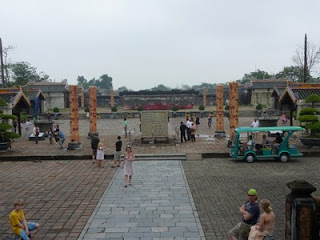
First, we visited the Royal Palace and Citadel, on the banks of the Perfumed River. This covers a large area and includes the Forbidden City. Unfortunately, 80% of this was destroyed in the wars by the French and the Americans. The pictures show a model of what it used to look like and what still remains. The Vietnamese are now undertaking a renovation project and eventually hope to rebuild some 40% of the initial complex.
After a short drive, we arrived at the tomb of Tu Doc, the 4th emperor of the Nguyen dynasty, who died in 1883 . This was in a lovely parkland setting, constructed by the emperor first as his summer palace, then as his final resting place. I don’t have a picture of his tomb, as no photos were allowed. However, it doesn’t really matter, as they say he would never have been interred in the tomb itself, because of the risk of grave robbers. Instead, he was buried secretly somewhere in the grounds.
 Finally, we went to the tomb of Khai Dinh, the 12th emperor of the Nguyen dynasty. He died in 1925, aged 40. He had 104 concubines, but, unfortunately, never sired any children. It’s not that he was gay, but the poor guy suffered from mumps when he was a child and that left him impotent. All those blanks he must have fired!
Finally, we went to the tomb of Khai Dinh, the 12th emperor of the Nguyen dynasty. He died in 1925, aged 40. He had 104 concubines, but, unfortunately, never sired any children. It’s not that he was gay, but the poor guy suffered from mumps when he was a child and that left him impotent. All those blanks he must have fired! 
 His tomb is truly impressive and was built with the help of the French. It’s hard to convey it properly in photos, but it’s on three levels, with lots of interesting things at each level. The tomb itself is right at the top and is magnificent. The walls of the room are completely covered in ceramics, all imported, mostly from China, France and Japan. From Japan they included soup spoons (see picture). He is buried beneath the tomb at the top, but some eighty metres below. Apparently, they used French engineers to help with the design and are supposed to have implemented a scheme that made it thief-proof. From what I could gather, it involves a sloping tunnel, dug in from the side, and some mechanism that is supposed to make tons of concrete fall on anyone who breaks through the sealed off tunnel. It sounds a lot like the Egyptian pyramids to me and they weren’t exactly foolproof, but this tomb does seem to have survived intact.
His tomb is truly impressive and was built with the help of the French. It’s hard to convey it properly in photos, but it’s on three levels, with lots of interesting things at each level. The tomb itself is right at the top and is magnificent. The walls of the room are completely covered in ceramics, all imported, mostly from China, France and Japan. From Japan they included soup spoons (see picture). He is buried beneath the tomb at the top, but some eighty metres below. Apparently, they used French engineers to help with the design and are supposed to have implemented a scheme that made it thief-proof. From what I could gather, it involves a sloping tunnel, dug in from the side, and some mechanism that is supposed to make tons of concrete fall on anyone who breaks through the sealed off tunnel. It sounds a lot like the Egyptian pyramids to me and they weren’t exactly foolproof, but this tomb does seem to have survived intact.
No comments:
Post a Comment